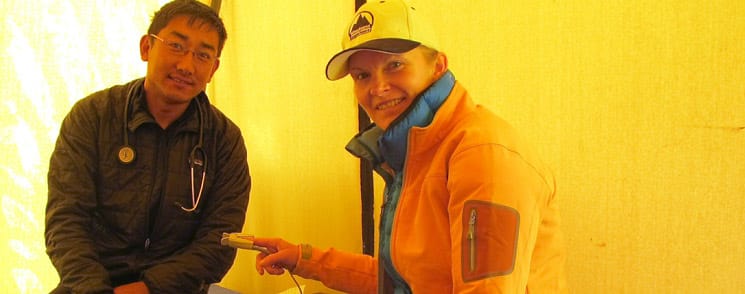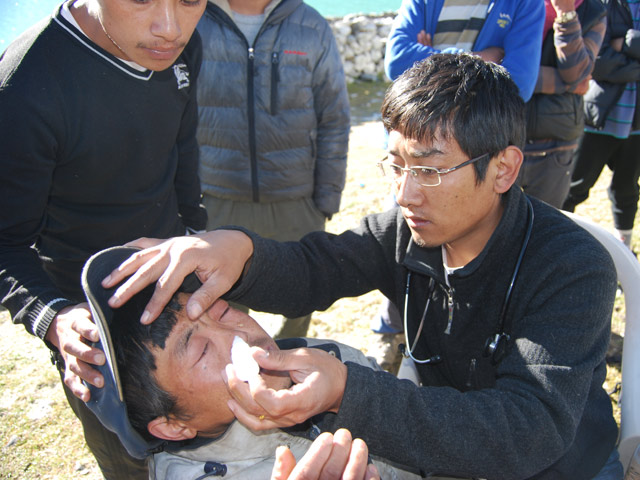The Sherpa doctor on Everest

From needle and syringe to crampons Dr. Nima carries it all in his backpack from BC to the summit of the 8000er
While most medical practitioners loop their stethoscope around their neck and tend to patients at hospitals, doctor Nima Namgyal Sherpa has a much higher call of duty. He is the only Expedition Doctor from Nepal belonging to the high-altitude mountain-guiding Sherpa community available from Base Camp to Summit of the tallest mountain on the planet -- Everest.
Dr. Nima was born and raised in the snow-clad mountains of Nepal in a remote village called Khumjung, one of the highest in the world at 3,970 mts. The 30-year-old attended the school built by Everest's first summiteer Sir Edmund Hillary and later studied medicine at Tianjin medical University in China as also earning diplomas in Mountain Medicine from Nepal and in Mountain Emergency Medicine from Italy.
No matter where he learnt his medicine from what was untaught to him was his duty to work in the Himalayan mountains and take on the challenge of working in the wilderness and extreme environment.
"I have lost relatives and friends on different mountains in Nepal. The best part of my job is being on the mountain providing medical assistant to climbers and my fellow Sherpa brothers to ensure their health is not compromised. Walking in together (till base camp) and coming back together as a team is equally important for me," Dr. Nima told The Outdoor Journal at Lukla airport at 2860 m in an exclusive interview. In 2012 he kept his medical apparatus aside for a while and took up the ice axe, put on his crampons and went on to summit Everest.
Presently working for Kathmandu-based expedition firms Himalayan Experience and Asian Trekking on Everest (8848m), Manaslu (8156m) and Amadablam (6812m), Dr. Nima plans to work with Seven Summits during the summer on Pakistan's renowned K2 (8611m) later in 2014.
"Sometimes during an expedition I feel helpless knowing that I can't let a client continue their climb due to their poor health. It's a tough call knowing that they have spent a lot of money and time to make their dream come true and achieve their goal. Death, of course, is not easy to take too during an expedition", says Dr. Nima who is also a diploma holder from National Outdoors Leadership School (NOLS), USA.
His time at work is spent inside tents that are stocked with life saving medicines and equipment to treat patients for a host of high altitude ailments. He is also trained to tend to an injury sustained during a fall, avalanche or due to a frostbite. "The toughest and the longest day of my assignment was when I was involved in the rescue operation of the Manaslu Avalanche where 11 people were killed. I had to walk down from Camp 1 to BC and worked all day attending to the avalanche victims airlifted from Camp 3 to Base Camp at 4,300 mts," he recalls.

Explaining the critical weightiness of his profession the Sherpa doctor says, "Normally, Expedition Doctors are hired for BC only but The International climbing and Mountaineering Federation (UIAA) medcom official standard for Expedition doctor requires adequate alpine experience. They should be able to climb to the highest camp should it be required."
Dr. Nima is one among the 30,000 odd Sherpa's who live in the Himalayan country of Nepal. Around 300 of them live in the Kumbhu region on the South side of Everest. Since the 1950's, tourism has become the main source of employment in the area for hundreds of Sherpas and other members of ethnic groups that work as part of the climbing and tourism industry. Sherpa's hold many impressive climbing records on Everest too.
Acknowledging Dr. Nima's role, Everest statistician Richard Salisbury told The Outdoor Journal that The Himalayan Database was has recorded as many as 135 physicians who have summitted the tallest mountain as Expedition Doctors or as mountaineers but the 30-year-old Sherpa doctor was the first of his ilk.
Amidst the heap of mountaineering laurels his community has received since the time Everest was summitted in 1953 by local climber Tenzing Norgay Sherpa and New Zealander Edmund Hillary, he was always clear that his contribution would be providing the best treatment on the toughest mountain.
"I plan to work for few more years and again continue further studies in the field of travel medicine. Mountaineering is my passion and I have been fortunate enough to combine it together with medicine. I got the opportunity to climb many mountains as part of my job as an expedition doctor. Most ED's start at Base Camp but what I do is different. I have spoken about my work at various hospitals in Nepal, UK, US and many people have show interest in becoming EDs but the challenges of working in the wilderness and extreme environment seems to keep them away," he says.
The mountain doctor is of the view that it is most important is to prevent and minimize the chances of being sick by preventive measures. "Its not the medicine I practice but rather it's the context in which I practice medicine. The remote environment, the need to improvise and to care for patients... and to do so in adverse and challenging terrain," the mountaineer-doctor says.
On Everest and other 8000ers people die or are affected by altitude sickness and even extreme exhaustion. "The casualties due to ailments has reduced over the years due to better medication, awareness, preparedness and presence of a handful of doctors. Better oxygen systems in the past grew years has also played a crucial role in fewer deaths," he adds.
The only 'sickness' the young doctor has no cure for is medico-legal issues that occur on the high mountains of the Himalayas. "Decisions are made on clinical findings only with limited resources. People who understand will cope but those with bad intentions will sue even for illness that we are not responsible like frostbite. There has been a case," he says signing off.Place: Lukla / Kathmandu, Nepal





Comments ()